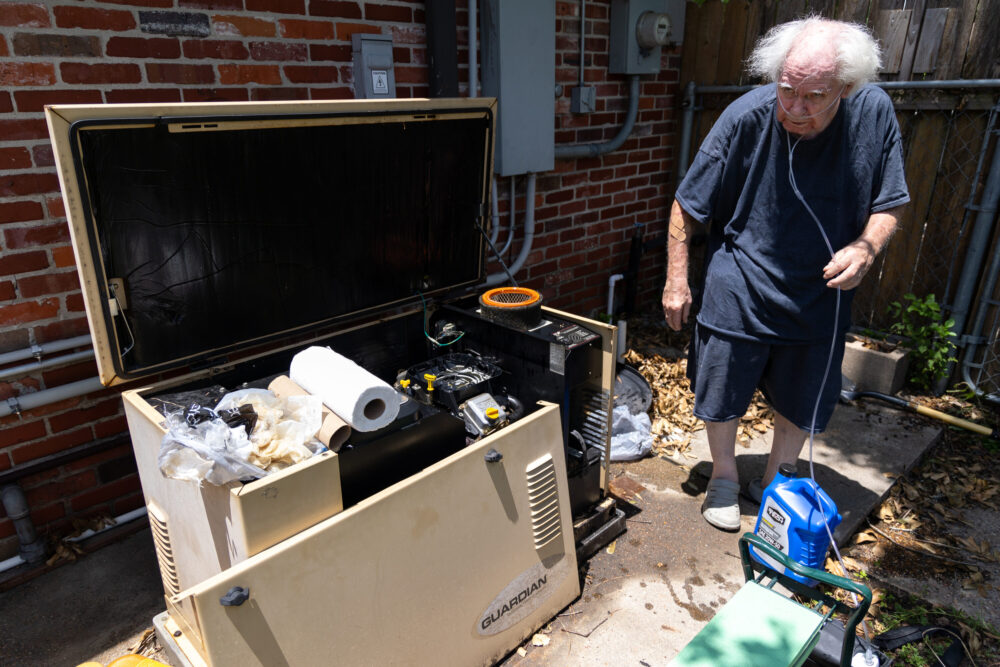AP Photograph/David J. Phillip
Months after wrapping up a multi-million greenback initiative to harden Houston’s power infrastructure after Hurricane Beryl left town at the hours of darkness, CenterPoint Power is now looking for to take a position practically $6 billion within the grid — and clients will once more foot the invoice.
CenterPoint filed an software for the venture — deemed the most important, and costliest, single grid resiliency funding within the firm’s historical past — with the Public Utility Fee of Texas on Jan. 31.
Outlined within the software paperwork, the Systemwide Resiliency Plan is predicted to maneuver practically 50 p.c of the corporate’s energy strains underground, deploy a vegetation administration cycle for transmission and distribution strains and set up self-healing automation units on strains to scale back potential outages.
The associated fee to clients would come as a $2 per 30 days enhance in 2026, one other $2 enhance in 2027 and up $3.33 per 30 days close to the tip of 2028, Logan Anderson, a CenterPoint Power spokesperson stated.
The plan, which touts an estimated $50 million saving yearly for purchasers, will assist CenterPoint in elevating payments to be in keeping with inflation and business friends on a proportion foundation, based on the corporate.
The Systemwide Resiliency Plan displays CenterPoint’s ramped up efforts following requires motion from lawmakers after Beryl and the utility fee’s request for a probe into the corporate’s funds.
Greater than 2.2 million CenterPoint Power clients have been with out energy following Hurricane Beryl, roughly 80% of CenterPoint’s clients. For greater than per week after the storm, lots of of hundreds remained with out electrical energy. Not less than 24 deaths throughout Harris County have been reported from circumstances associated to the storm, together with a number of attributed to hyperthermia after temperatures skyrocketed.

Lucio Vasquez / Houston Public Media
Final 12 months, CenterPoint launched a multi-phase enchancment plan after calls for from Gov. Greg Abbott. Deemed the Better Houston Resiliency Initiative, the corporate trimmed vegetation round greater than 2,000 energy strains, put in or changed 25,000 poles to satisfy excessive wind requirements and launched a year-round public emergency communications marketing campaign.
In an announcement to Houston Public Media, the corporate stated the most recent resiliency plan “is a significant step on the corporate’s strategic roadmap to changing into probably the most resilient coastal grid within the nation.”
“By means of the resiliency enhancements of the Better Houston Resiliency Initiative and the proposed Systemwide Resiliency Plan, clients will proceed to see the advantages and the worth of improved resiliency earlier than invoice impacts would start in mid-2027,” based on the assertion. “Additionally, as a reminder, CenterPoint’s portion of the invoice has remained basically flat for a decade- about $50.”
The plan comes months after the corporate wrapped up comparable initiatives geared toward bettering town’s power resilience, and simply days after the corporate stated that Houston-area clients will see decrease charges on month-to-month payments after settling its 2024 charge case after months of negotiations.
Sandra Haverlah, president of the Texas Shopper Affiliation, stated the frequent charge case changes might give shoppers within the firm’s territory whiplash.
“I believe there needs to be numerous evaluation on whether or not or not clients are double and triple paying for gear, since you had the derecho, Beryl, each current storms the place model new gear was put in,” she stated.
Final 12 months, CenterPoint Power executives repeatedly defended an $800 million lease of cellular mills that went unused throughout Beryl. The mills, which have been initially leased in response to 2021 Winter Storm Uri, have been a most important sticking level for a lot of arguments opposing the corporate’s actions throughout Hurricane Beryl. The corporate has since ramped up efforts to construct belief with its clients, however prices to enhance Houston’s grid in preparation for hurricane season might proceed piling up.
RELATED: CenterPoint goals to push price of repairing Hurricane Beryl’s injury onto Houston-area ratepayers
“I don’t know that there’s an finish in sight to this as a result of you might have development along with changing previous gear, and a part of this plan can also be placing a few of it underground,” Haverlah stated. “Retrofitting underground is extraordinarily costly and proper now I don’t suppose any evaluation has been completed on the plan to see if the place they’re proposing the gear to be put in, plus the underground work to be completed, is the optimum place to do it and if it’s value the fee to do it.”
If authorized by state officers, the venture is predicted to keep away from outages for greater than 500,000 clients within the occasion of one other storm like Beryl. It’ll additionally elevate 99 p.c of substations above the 500-year flood plain, and set up 130,000 extra storm-resilient poles.
A survey carried out by the College of Houston’s Interest College final 12 months discovered that just about 50 p.c of Harris County residents stated that they plan to go away Houston, with most citing climate considerations. Greater than 80 p.c of respondents to that survey additionally stated CenterPoint must be solely answerable for footing the prices of the unused mills — not the taxpayers.
“In some unspecified time in the future, there’s a cost-benefit to all of this and clearly clients don’t need to be left with out energy for days on finish after a hurricane, however numerous that was as a consequence of vegetation as effectively… and never the gear itself,” Haverlah stated. “I believe there’s a steadiness between what clients can afford and what they really want when it comes to the system.”

